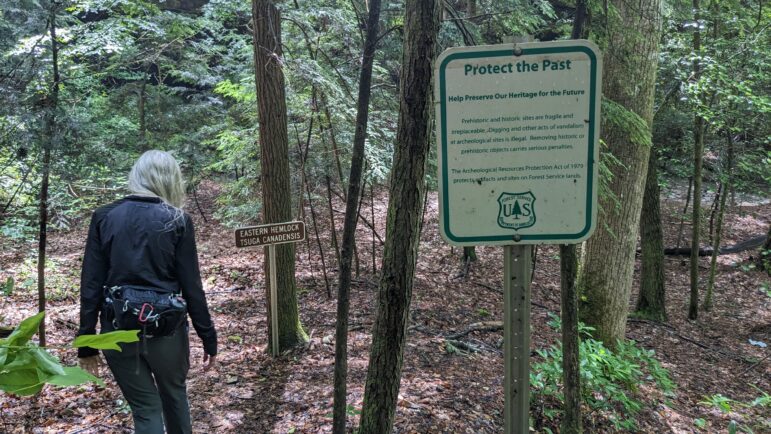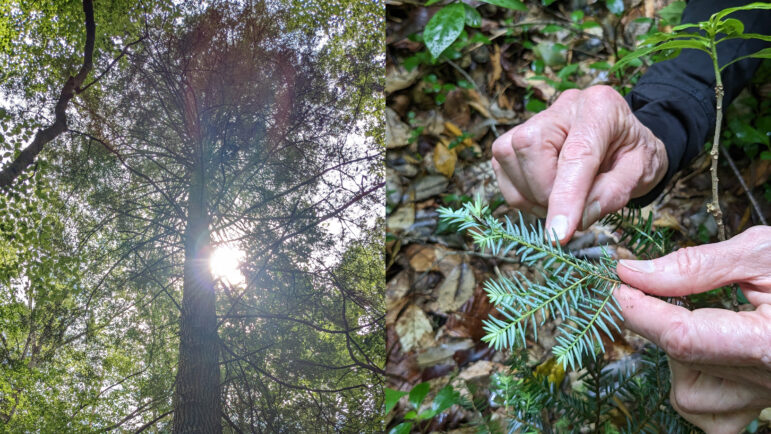Alabama’s hemlocks face threat from a deadly insect
This story is part of a monthly series called Outdoor Connections, which features stories that explore the biodiversity of Alabama and how we depend on it.
Walking along a trail in the middle of Bankhead National Forest, a drizzle of rain makes for a surprisingly cool June day.
“I love being out here when it’s raining,” said forest guide Janice Barrett. “Even in pouring rain, where we’re going is so perfect.”
As the outreach and education coordinator with the nonprofit Wild Alabama, Barrett describes her job as “giving people the opportunity to let the forest teach them.”
On this day, she’s in the woods to teach about the eastern hemlock, an ancient evergreen tree found along the east coast. While not one of the state’s most common species, the hemlock’s southern footprint ends in Alabama, where its scattered populations nurture a unique habitat for diverse plants and animals.
Forest officials say hemlocks are vital to the state’s biodiversity, but they face a looming threat, a deadly insect that has slowly made its way south.
Now Barrett, along with state and national forest officials, are making more frequent trips to Bankhead’s canyons to monitor the species and hopefully mitigate the risk.
The hemlock through the trees
For the untrained eye, identifying the first hemlock may be difficult amid a lush green forest full of pine trees, hardwoods and bright ferns. But the tree is unmistakable after descending into one of Bankhead’s damp canyons.
Barrett describes the habitat as “heaven.”
“This is definitely a hemlock ecosystem,” she said.
The evergreens tower above the forest floor, filtering sunlight through their droopy branches.

Barrett said the trees enrich the soil and keep the water cool, maintaining prime habitat for an abundance of plants and animals.
“Alabama has world class biodiversity and mainly in aquatic species,” she said. “This is one of the reasons, because of these hemlock forests. So if we were to lose our hemlocks, it would change a lot here.”
Right now, Bankhead’s hemlock population is healthy, but that’s not the case in other parts of the country.
For decades, up and down the east coast, the trees have been under attack by a small insect called the hemlock woolly adelgid.
Danger moving closer and closer
Native to Japan and China, the adelgid was first detected feeding off of eastern hemlocks in Virginia in the 1950s. The slow-moving insect has since migrated to at least 17 states.
“We are basically the only location left that hasn’t been attacked in the eastern United States,” said Andy Scott, district ranger at Bankhead National Forest.
Scott said once the adelgid infects a population of hemlocks, it’s catastrophic. One of the only mitigating options for forest officials is to inject a pesticide into select tree trunks.
“If you go to the Appalachians, such as in North Carolina, you really won’t hardly find any hemlock that hasn’t either been killed or is dying except for where it has been treated,” Scott said.
While the adelgid has not yet been detected in Bankhead, the threat is moving closer and closer, having recently been found roughly 100 miles east, near Mentone, Alabama.
“The main thing that’s saving the trees in this part of the state is that this is a disjunct population from the ones in the east,” Barrett said. “So there’s a pretty good distance between our trees here and the ones in east Alabama.”
That may help slow down the insect, but forest officials say there’s not much they can do to keep the adelgid out of Bankhead all together. So they’re keeping a close eye out for the species.
“If it comes here, we’ll still lose a substantial part (of the population),” Scott said. “But we do have a plan to try to protect and maintain some areas.”
Early detection
For about 10 years, the U.S. Forest Service has been monitoring hemlocks at Bankhead as part of a nationwide program.
“Working with Wild Alabama was the idea to expand that monitoring to have more of an early warning system,” Scott said.
For the past year, Barrett and fellow Wild Alabama staff have trained volunteer groups, scout organizations and school kids. They learn to look for a white fuzzy substance that the pest leaves underneath the tree’s branches.
“So we’re teaching people how to identify the adelgid, the thing that we hope to never see,” Barrett said. “And also identify the plants that grow in the hemlock ecosystem.”
She said it’s a great way to get the community involved with conservation work.

Wrapping up the hike in the canyon, Barrett crosses a creek to take a closer look at one of the area’s biggest hemlocks.
The tree is thick, its slabby bark covered with lichen and moss. Barrett said it’s impossible to guess the tree’s age, with some hemlocks living hundreds of years. But it’s easier to identify a baby hemlock sprouting from the ground nearby.
Barrett said both are signs of a healthy forest, and she’s doing all she can to keep it that way.
Do you have an idea worth featuring as part of our Outdoor Connections series? Email maryscott@wbhm.org.
Judge blocks Trump administration from closing the Education Department
The federal judge also told the administration to reinstate department employees who lost their jobs during the reduction-in-force announced in March.
DOGE cuts, policy changes jeopardize care, housing for vulnerable HIV patients in Alabama
Federal funding has helped states like Alabama and Mississippi make strides in fighting the HIV epidemic. Doctors and advocates are worried about the future.
Senate overrules parliamentarian and votes to undo California EV rule
The Senate parliamentarian advised lawmakers that they couldn't use the Congressional Review Act to revoke California's right to set vehicle standards. But they did it anyway. Expect a legal fight.
Is AI coming for your job? Maybe. Here’s what to expect and how to prepare
Artificial intelligence is already transforming workplaces in Alabama. And the pace of the AI revolution is about to accelerate.
South Africa’s president praised for staying calm during Trump’s Oval Office ambush
South Africa's President Cyril Ramaphosa keeps his cool after a carefully choreographed Oval Office ambush by Trump.
Judge considers sanctions against attorneys in prison case for using AI in court filings
U.S. District Judge Anna Manasco held a hearing in Birmingham to question attorneys with the Butler Snow firm about the filings. She said there were five false citations in two filings in federal court.









